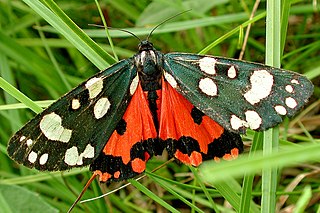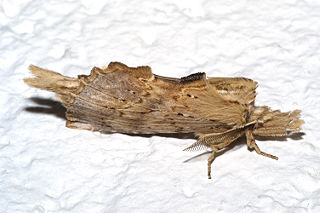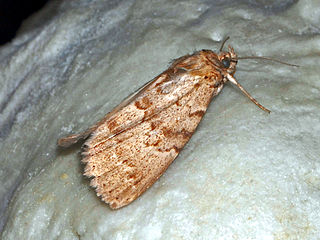
The scarlet tiger moth is a colorful moth belonging to the tiger moth subfamily, Arctiinae. The species was first described by Carl Linnaeus in his 1758 10th edition of Systema Naturae.

The ringlet is a butterfly in the family Nymphalidae. It is only one of the numerous "ringlet" butterflies in the tribe Satyrini.

Melitaea diamina, the false heath fritillary, is a butterfly of the family Nymphalidae.

The scarce copper is a butterfly of the family Lycaenidae.

Hyles gallii, the bedstraw hawk-moth or galium sphinx, is a moth of the family Sphingidae. The species was first described by S. A. von Rottemburg in 1775.

Parnassius stubbendorfi is a high-altitude butterfly found in from the Altai Mountains across central, south, and far east Siberia, Sakhalin and the Kuril Islands and from Mongolia across north China to west Korea and Japan (Hokkaido). It is a member of the snow Apollo genus (Parnassius) of the swallowtail family (Papilionidae).

Pterostoma palpina, the pale prominent, is a moth from the family Notodontidae. The species was first described by Carl Alexander Clerck in 1759.

Erebia euryale, the large ringlet, is a species of butterfly belonging to the family Nymphalidae.

Abraxas sylvata, the clouded magpie, is a Palearctic moth of the family Geometridae that was named by Giovanni Antonio Scopoli in 1763.

Siona lineata, the black-veined moth, is a moth of the family Geometridae. The species was first described by Giovanni Antonio Scopoli in his 1763 Entomologia Carniolica.

Hipparchia statilinus, the tree grayling, is a butterfly of the family Nymphalidae.

Coenonympha arcania, the pearly heath, is a butterfly species belonging to the family Nymphalidae.

Emmelia trabealis, the spotted sulphur, is a moth of the family Noctuidae. The species was first described by Giovanni Antonio Scopoli his 1763 Entomologia Carniolica.

Setina irrorella, the dew moth, is a moth of the family Erebidae. The species was first described by Carl Linnaeus in his 1758 10th edition of Systema Naturae. It is found in the Palearctic from Ireland, then through Europe and east to northern and central Asia to the Pacific Ocean. It is missing in the high north and parts of the Mediterranean region. It is found also in the limestone Alps up to 2,000 meters above sea level.

Katha depressa, the buff footman, is a moth of the family Erebidae found in Asia and Europe. It was first described by Eugenius Johann Christoph Esper in 1787.

Eilema caniola, the hoary footman, is a moth of the family Erebidae. The species was first described by Jacob Hübner in 1808.

Cymbalophora pudica, the discrete chaperon, is a moth of the family Erebidae. The species was first described by Eugenius Johann Christoph Esper in 1784.

Syssphinx bicolor, the honey locust moth, is a North American moth in the family Saturniidae.

Apopestes spectrum is a species of moth in the family Erebidae first described by Eugenius Johann Christoph Esper in 1787.

Dichromodes ida is a moth of the family Geometridae. This species was first described by George Hudson in 1905. It is endemic to New Zealand and is found in Central Otago. This species inhabits open rocky places at altitudes between 100m to 900m. The larvae of D. ida are cryptic in appearance and feed on lichens growing on rocks. They appear to pupate in rock clefts, forming a chamber made of moss and silk. Adults are day flying and are on the wing from October until December.






















